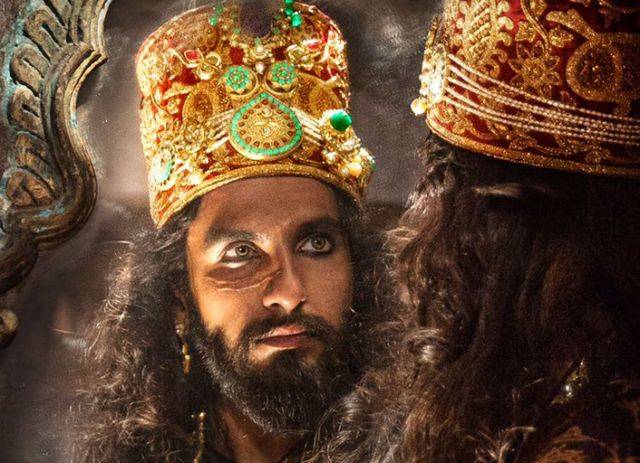With one’s daily routine crammed up with interminable happenings and unavoidable commitments, one looks for ways of relaxation over weekends and choosing to go to the cinema theatre for a two-hour watch is always an exciting option, however, films like “Padmavati” instill within you a kind of distaste for the entire movie-watching experience; an embitterment that you cannot rid yourself off for a long, long time.
After watching the film last night, I felt like Allaudin Khilji who had no other business in the world than to oscillate between Delhi and Chittor only to get a glimpse of a queen who never even existed in real. Nobody ever knew he was suffering from such massive lack of work. It is so hard to believe that a director like Bhansali, with the kind of infrastructure he enjoys in India as well as in the international arena, would glorify to this extent a Rani who solely exists in the fictional realms of the poem by Jayasi – a character artificially constructed to honour women's courage in general, or should we say to simply offer a slice of some unusual poetic sensibility at that point in time.
Where there is so much commending and applause for the costumes, songs and graphics, there is very little critique and evaluation presented in India over the silly imitation of scenes and characters from a myriad of Hollywood films was another of the many, many disappointments. The duel between Ratan Sen and Allaudin Khilji was a convenient copy-paste of the Hector-and-Achilles scene from “Troy”, while the whole Khilji army marching to Chittor from Delhi for the beguiling beauty of a woman in itself reminded the audiences of the Trojan War and the Helen of Troy in many ways. Apart from this, some scenes between Malik Kafoor and Khilji were also close imitations of the personal relationship that Alexander had with the eunuch, Bagoas, in Colin Farell’s 2004 movie, “Alexander: The Ultimate Cut”.
Khilji’s brilliance as a warrior, his contributions to the economy of India, his fair initiatives of establishing a system of dialogue with rigid Hindu feudal landlords, his accomplishments as a great statesmanship, all have been neatly concealed in the film by the façade of a perpetually-drunk, cynical womanizer whose army always attacked from the back, who dealt the enemy with subversive tactics and who teamed up with deceitful ones to achieve personalized petty agendas – it’s almost like the director dropped every evil at Khilji’s door! Khilji was no doubt a tough ruler, but that by no way, means he can be defined as anyone even being close to Bhansali's version of Allaudin: the preposterous swindler, psychotic and ruffianof a character performed by Ranveer Singh.
Any film, no matter how great a directorial marvel it is, must not distort history to offer undue acquiescence to social agendas. The film appeared to be a typical Bollywood romance story with the fictional character of Padmavati almost being used as a prop to showcase how unjust, spineless and coward the Muslim rulers of India were – one does not even understand as to why the vandalizing by the Rajput community in India was done on such an expansive scale upon the release, when it should rather have been the Muslims of India and Pakistan who needed to respond to the ways in which they have been, at times euphemistically and at times nakedly, mocked in the film.
The Khilji flag (which seemed pretty much like the Pakistani flag, in green hues and a white crescent), the portrayal of Muslim armies as unscrupulous, their war ethics as being thoroughly rotten and fundamentally bad, and then semiotically the crisp white uniforms of the Rajputs in contrast to the detestable dark uniforms of the Muslim army with their purposely moustache-less faces bedecked with a strange bloodlust, literally was a manifestation of the directorial effort to demonize all Muslims who reigned over India, vilify the Muslim community in general, as well as to denigrate the neighbouring country.
It is understandable that Khilji’s goodness and his achievements were not what the film wanted to epitomize, however what is needed to be analyzed is the overarching theme of a historical figure being discussed here, and when that is done, certain “documented” facts and qualities of that figure cannot be so conveniently brushed under the carpet, while capitalizing on his darker side (which was, by the way, nothing unusual about rulers back then, the Guptas, Mauryas, Sungas and Chauhans exhibited it too) to antagonize a significant historical figure only because he exists as an antagonist in the creative story coined by the director’s mind.
One cannot “re-present” a historical figure as an absolute monster; to hell with the veneer of creativity if it changes people's perceptions by filling their heads with bogus information.
A film turns opinions because it is an act of what the modernist term describes as "re-storying"; Every thinking mind understands the importance of film, media and cinematographically represented concepts. The inexorableness of how films have more currency than history books in Pakistan and India,is a fact that is needless to state. Visual representations have always been stronger in influencing individuals on a large scale, because a giant, sprawling segment of the Pakistani and Indian masses wants and likes “watching movies” instead of “reading books”.
It is no denying that the history we read today in books too has been intensely coloured so many times by the individual prejudices of historians with diverse backgrounds that what we read or are told is "his/her-story" instead of one creditable "history", however any director who undertakes the responsibility of making a film based on historical narration, must not distort documented facts and/or merge facts and fiction with such extensity, that the film in a way makes a cake out of itself.






